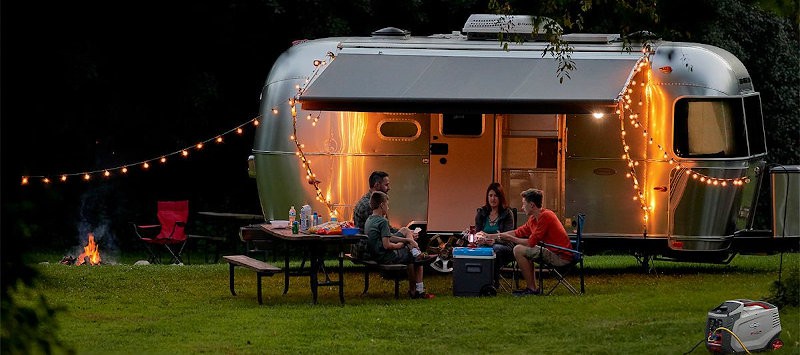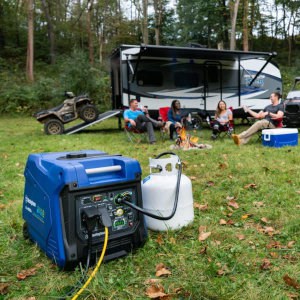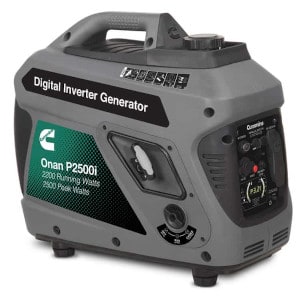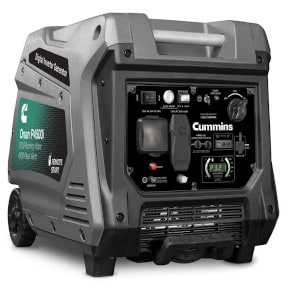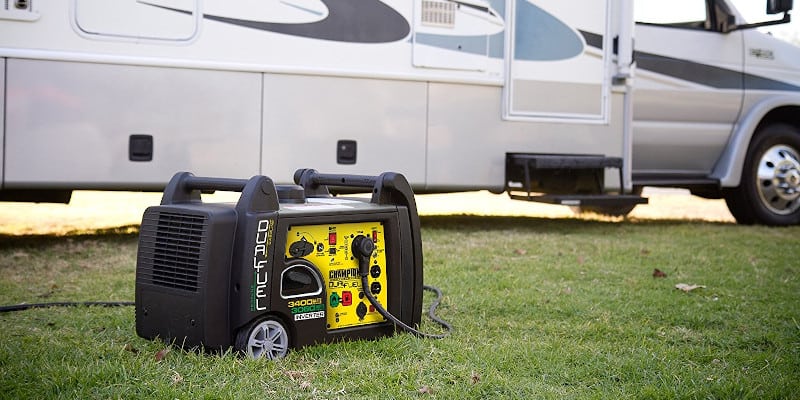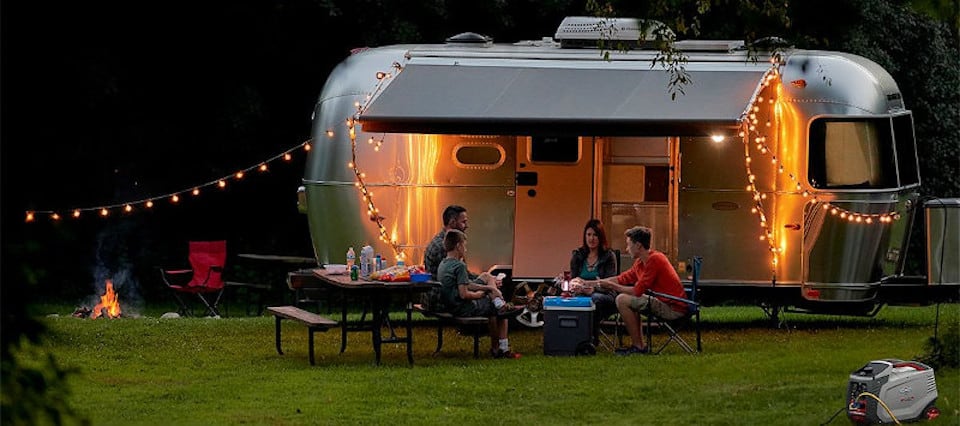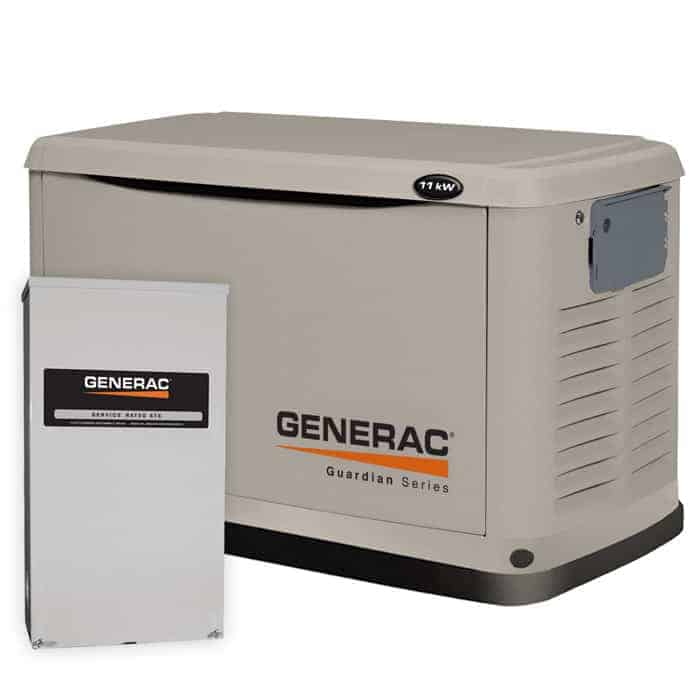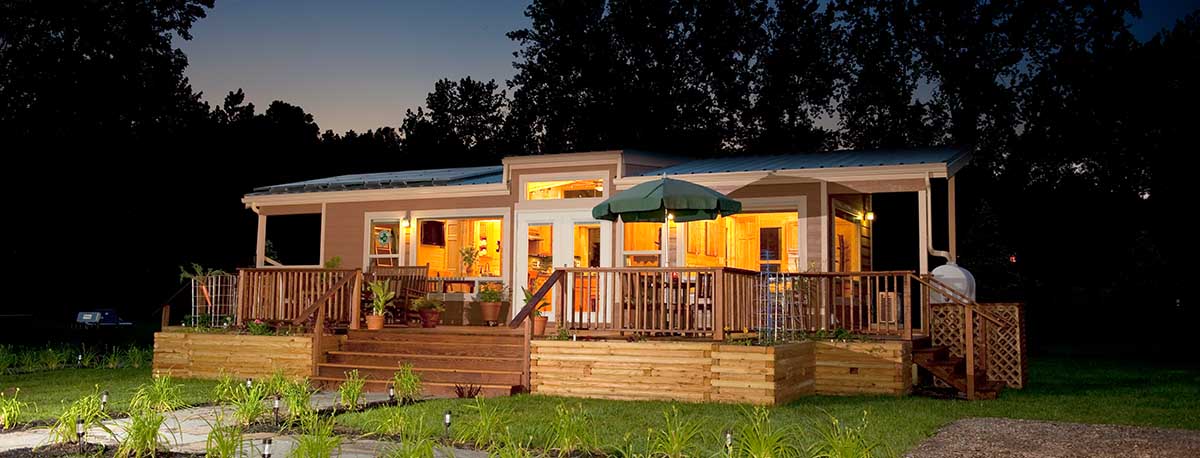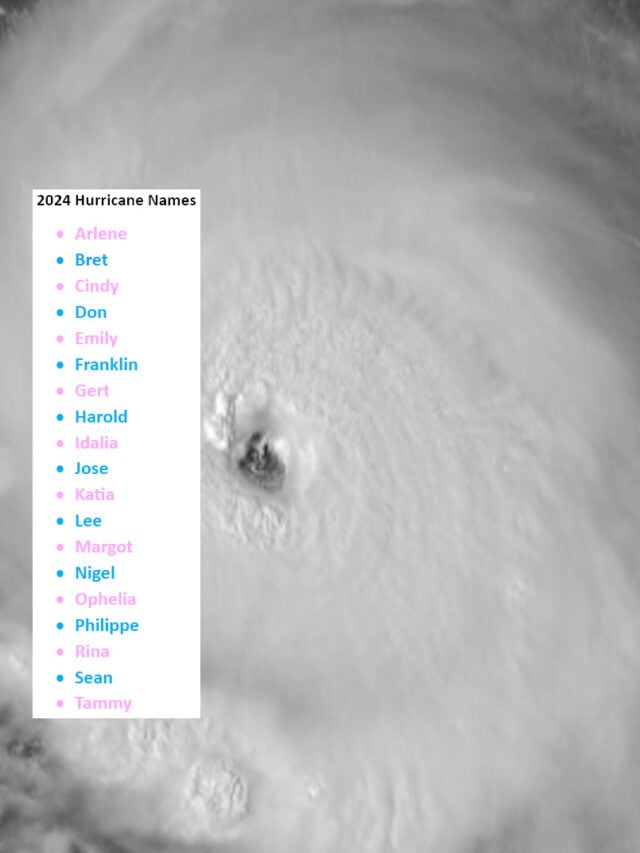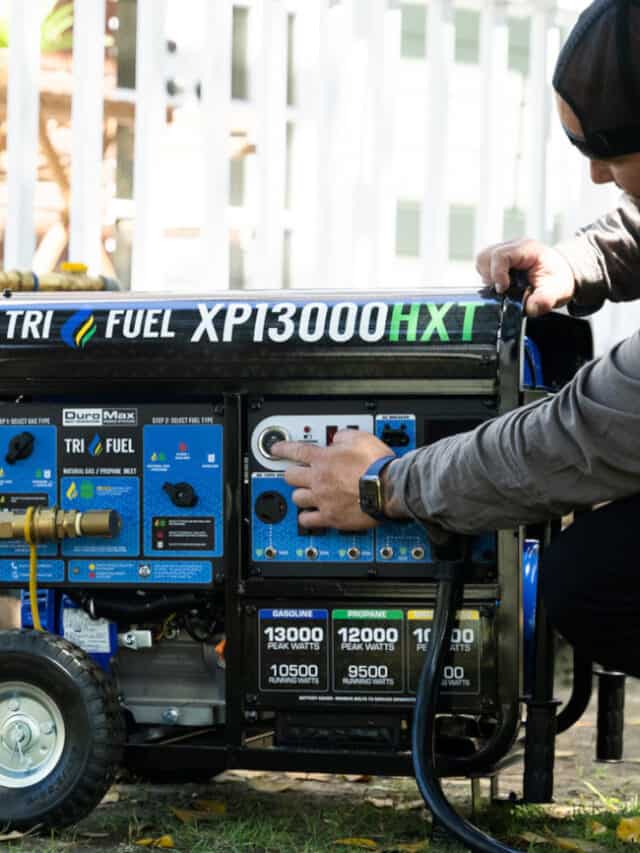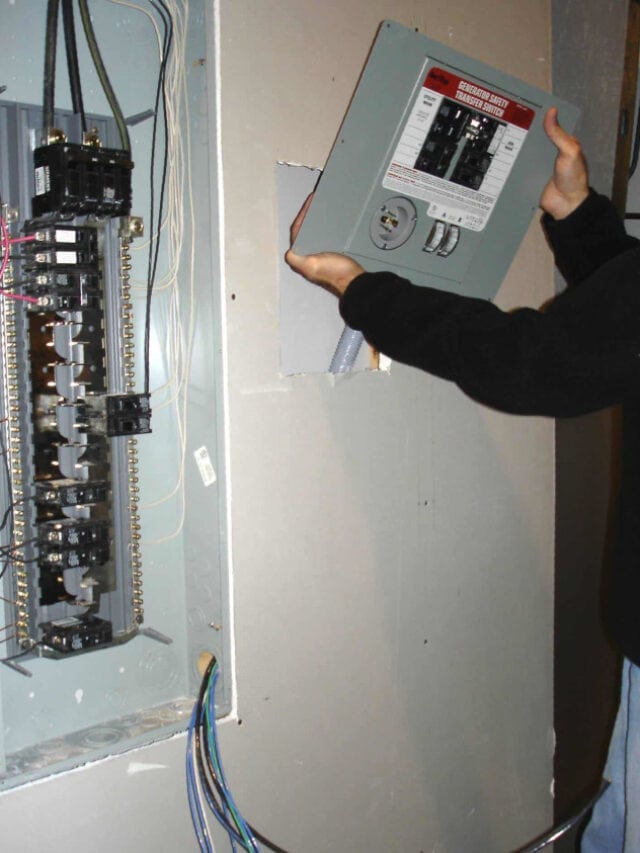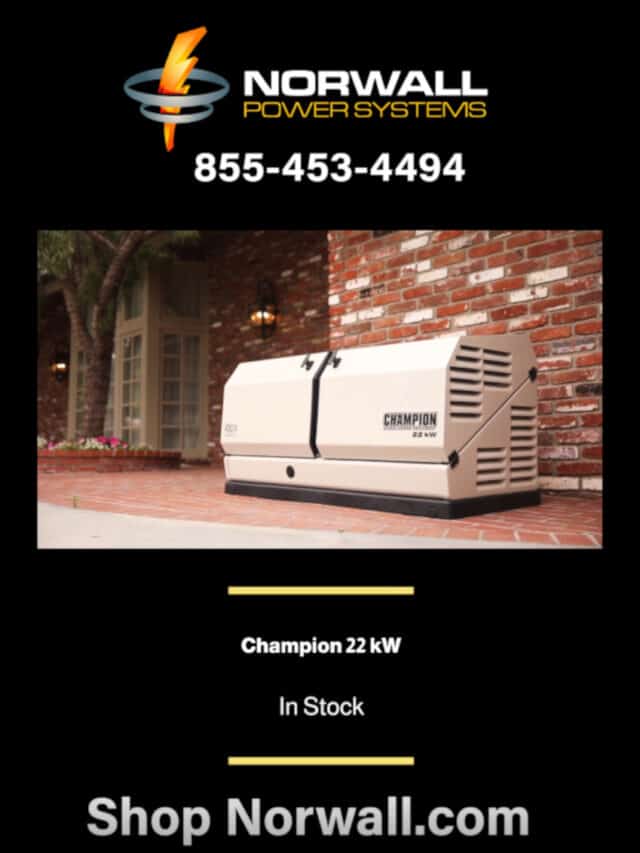Portable RV Generators power everything from festive lights to air conditioning and coffee makers.
How to Pick the Best Inverter Generator for RV Use in Parks or Remote Campsites
Trailer RVs, Popup Campers, and Truck Campers do not always come with a built-in generator. Shore power at many campgrounds and RV parks supply electricity for appliances, lights, and air conditioning. You’re on your own when boondocking in remote locations or a big box store parking lot. If you don’t have an RV generator, you rely on house batteries which won’t last long running major appliances.
A regular portable generator might be one solution, but for today’s RV family, they are too noisy, use too much fuel, and are not quite as portable as their name implies. A 3600-watt generator can weigh more than 100 pounds empty and 140 pounds with a full fuel tank. Without an RV outlet, you’ll need an adapter. They make more noise than allowed in most RV Parks or National Park Campgrounds.
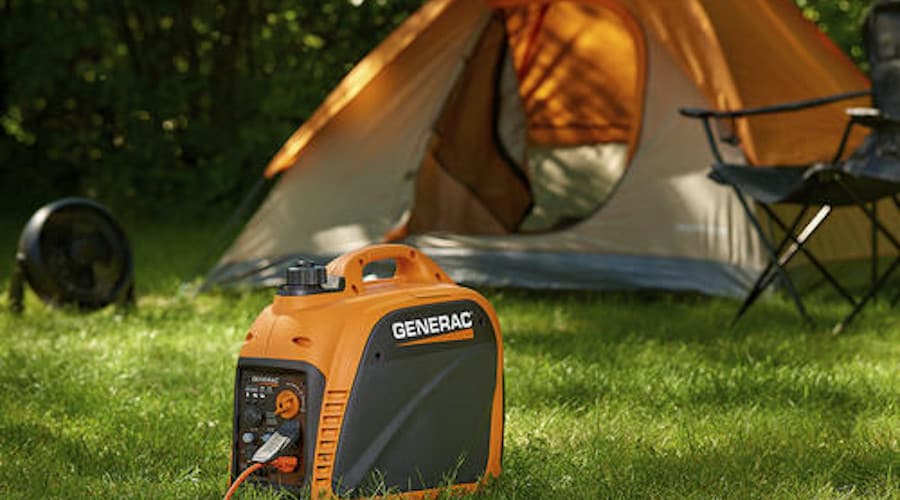
The Generac GP2200i Portable Inverter Generator—Quiet and Fuel Efficient. Easy to Move and Store
A Better Portable Generator for an RV
The inverter generator is a relatively new addition to the Portable RV Generator market. They run quiet, sip fuel instead of gulp, and in general weigh less than their regular counterparts. Smaller models weigh as little as 46 pounds.
A standard portable generator engine runs at a constant speed of 3600 RPM in order to maintain the correct frequency of 60hz. Inverters work different and use fuel efficiently by changing the speed to match the power requirements. At low power use, they run slower which uses less fuel and makes less noise. As the power goes up, they increase speed to increase the power.
A portable inverter generator produces clean power with very low distortion—important for sensitive electronics and great for appliances. The changing engine speed produces variable frequency power. A rectifier converts it to DC, then an inverter circuit converts it back to AC at a fixed frequency of 60hz. A good portable inverter generator produces clean AC power with very little distortion.
Take your RV anywhere with a Cummins P4500i Generator
RV Inverter Generator Features
The market is loaded with inverter generators that promise power for everything from RVing to Home Backup and Jobsites. However, many of these portable inverter generators don’t have the features that make them ideal for RVing. Here’s a few things to keep in mind while shopping.
Available Outlets
Travel Trailer Ready 30-Amp. The TTR-30 outlet mimics the shore power outlet found at campgrounds and RV parks. Plug your shore power cord in and you’re ready to go. Without the TTR-30, you’ll need an adapter that works with the generator standard outlets.
Single or Duplex 120-Volt. The same as a standard home outlet, most are 20-Amp outlets though some models are 15-Amp. Keep in mind that the although the generator has multiple outlets, you can’t exceed the capacity of the generator or the main circuit breaker will trip. These outlets are useful for extension cords for tools and outdoor lights, or for RVs without a shore power connection.
5-Volt USB. Handy for charging cell phones, spare batteries, Bluetooth devices, tablets, and other electronics.
12-Volt Automotive. Accepts 12-Volt cigarette-lighter type plugs for 12-volt chargers, automotive USB adapters, and small appliances.
Power Capacity
All generators have two power ratings, continuous running watts and surge watts. Continuous is the maximum rated continuous use. The surge rating allows the generator to supply the extra power to start an electric motor. It can only do that for a few seconds. Once the motor starts, it needs less power to keep running.
Your generator must have enough surge power to start your largest motor (usually the air conditioner) and then keep it running along with the other appliances and lights.
Many Portable RV Generators are named for their Surge Capacity. Often the manufacturer will include the surge watts rating in the model name. For example, the Cummins P4500i has a surge rating of 4500 watts, and a continuous rating of 3700 watts.
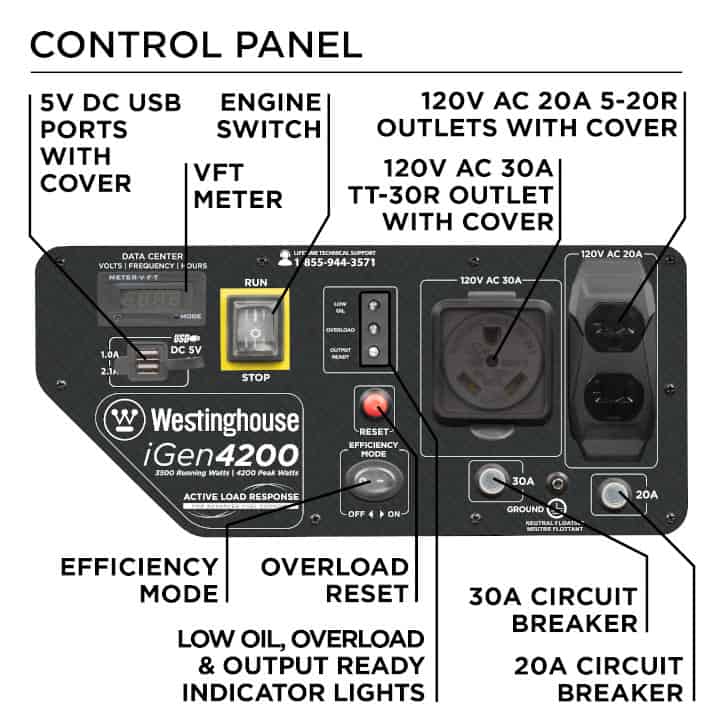
Westinghouse iGen4200 panel with outlets and circuit breakers for 120V 30A TTR-30, 120V 20 Amp 5-20R Duplex,, and 5V USB Outlets.

TheWestinghouse iGen4200 is rated for 4200 starting watts (also called peak or surge watts) and 3500 running watts, the continuous rated capacity.
Buyer Tip: Determine How Much Power You Need and add a 25 percent Margin to find the running watts required. Keep in mind that as power capacity increases, so does fuel consumption.
A Related Feature allows two portable inverter generators to combine their power for up to double the capacity. Parallel Operation is great for times when you need more power. When you need less power, run one generator and save on fuel and noise.
Noise
National Park Service rules limit noise from generators to 60 dBA at 50 feet. This eliminates many large portables and some medium portables. Good portable RV inverter generators make less noise. Look for a noise rating in decibels starting in the low 50s and ending in the low 60s. For example, 52 dBA or 58 dB(A).
For comparison, 40 dBA is the noise a desktop computer makes. Light traffic or your refrigerator rates about 50 dBA. A conversation between two people a few feet apart—60 dBA. Most vacuum cleaners run at about 75 dBA. Snowblowers and lawnmowers come in at 85-90 dBA which can be
uncomfortable without hearing protection.
You and everyone else in the park or campground are there to get away from noise and enjoy the peaceful great outdoors. Pick a portable RV generator that won’t disturb your neighbors or your family.
Westinghouse iGen4500 Dual Fuel Inverter Generator on an RV Boondocking Trip
Fuel Use
Run time ratings on generators indicate how long the generator can run on a single tank of fuel, whether it’s propane, gasoline, or diesel. Ratings are given for 25 percent rated load, 50 percent rated load, and 100 percent rated load.
Run time ratings on generators indicate how long the generator can run on a single tank of fuel, whether it’s propane, gasoline, or diesel. Ratings are given for 25 percent rated load, 50 percent rated load, and 100 percent rated load.
Portable RV Generators operate on either gasoline or propane, or both. A dual fuel option allows you to connect a propane tank like the one purchased for a gas grill or operate on gasoline. The rated continuous watts and surge capacity decreases with propane on dual-fuel gasoline/propane generators.
Expect 50 to 75 percent longer run times on inverter generators compared to standard portable generators on the same amount of fuel. If 4 gallons gives you 9 hours of run time on a standard portable, expect 14 to 17 hours on a similar sized inverter portable generator for an RV.
Purchasing a generator with the intention of operating it at 100 percent rated load is poor economy. The generator probably won’t last as long and there is no margin for adding additional load in the future. Always add a 25 to 35 percent margin on top of the estimated running watts required.
The Cummins-Onan P2500i portable rv generator makes runs 8 hours on a gallon of gas and makes just 52dBA noise. Great for popup and truck campers or tent camping.
Now the most popular Portable RV Generator available, The Cummins-Onan P4500i (below) has a TTR-30, duplex 120-Volt household, and USB charging outlets.
Best Portable Inverter Generator for RV Use
The Cummins Onan P4500i with 3700 watts of continuous power weighs less than 100 pounds and runs for 15 hours on a tank of gas. Built in wheels and a telescoping handle make moving it over rough ground a breeze. It comes equipped with a TTR-30 outlet, USB charging ports, and standard 120V outlets. With remote start, you won’t go outside to start it. Perhaps best of all, it produces just 52 dBA noise at the low end of power use. Stand a few feet away and have a
conversation without raising your voice.
At just 48 pounds, the Cummins P2500i has a 2200 continuous watts rating, makes just 52 dBA noise, and
runs 8 hours on 1 gallon of gasoline. It lacks a TTR-30 outlet, but has a 12-volt charger outlet, 5-USB charging ports, and two 120-Volt outlets.
Both Cummins Portable RV Generators accept a Parallel kit.
The Champion 3400 Portable Generator for RV use has remote start and runs for 7.5 hours on 1.6 gallons of fuel at 25 percent load. Built-in wheels and a tow handle make moving the 95-pound portable RV generator over rough ground easy. RV ready with a TTR-30 outlet, a pair of 120-Volt outlets, and a 12-Volt DC Automotive outlet. This inverter generator makes 58 dBA noise. The Champion Dual-Fuel 3100/3400 Portable RV has all the features of the 3400 but uses electric start instead of remote. Both generators are parallel capable with the Champion Parallel Kit.
Briggs and Stratton’s Powersmart 3000 supplies 2600 continuous watts and 3000 surge watts. Built in wheels and telescoping handle for easy moves or use the twin handle for two people to
carry the 84-pound generator. Although it lacks a TTR-30 outlet, it does have a 30-Amp, 120-Volt outlet for use with an RV shore power adapter. Other outlets include a 5-Volt USB for charging electronics, a 12-Volt DC Automotive outlet, and two 120V 20 Amp household receptacles. Parallel capable with the Briggs and Stratton Inverter Parallel Kit.
The Generac GP2200i Inverter Generator (above) weighs just 46 pounds and runs for 10 hours on 1.2 gallons of gas. Rated for 1700 running watts and 2200 starting watts, this small lightweight generator packs plenty of power for lights and small appliances in popup campers, truck campers, and small trailer RVs. Parallel Capable with the Generac Parallel kit.

